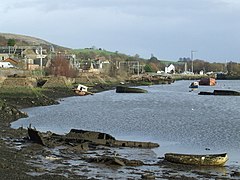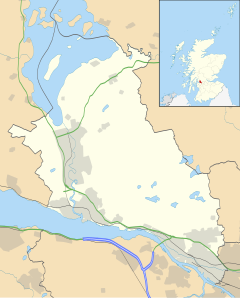Bowling, Scotland
Bowling
|
|
|---|---|
 Bowling Harbour in 2008 |
|
| Bowling shown within West Dunbartonshire | |
| Population | 5,500 |
| OS grid reference | NS445737 |
| Civil parish | |
| Council area | |
| Lieutenancy area | |
| Country | Scotland |
| Sovereign state | United Kingdom |
| Post town | GLASGOW |
| Postcode district | G60 |
| Dialling code | 01389 |
| Police | Scottish |
| Fire | Scottish |
| Ambulance | Scottish |
| EU Parliament | Scotland |
| UK Parliament | |
| Scottish Parliament | |
Bowling (Scots: Bowlin,Scottish Gaelic: Bolan) is a village in West Dunbartonshire, Scotland, with a population of 740 (2015).
It lies on the north bank of the Firth of Clyde, between the towns of Clydebank and Dumbarton. It is at one end of the Antonine Wall and therefore represents the extreme limit of the Roman Empire on the west coast of the island of Great Britain.
Bowling is the location of the western terminus of the Forth and Clyde Canal, opened in 1790, and it is the western gateway to the Lowland canals.
In 2008, British Waterways Scotland, in conjunction with Scottish Enterprise Dunbartonshire, completed a £1.4 million regeneration programme at Bowling Basin to provide additional moorings and improved facilities. At the time there were plans for future use of an area of 140 acres (60 hectares) of land adjacent to Bowling, in conjunction with Clydeport.
In June 2008, Lord Provost Denis Agnew, joined local schoolchildren and community groups to celebrate the completion of a £163,000 project to improve seven kilometres of towpath on the Forth & Clyde Canal from Bowling Harbour to Whitecrook in Clydebank.
In 2007, Bowling welcomed the "Vital Spark", one of only five surviving Clyde puffers, and the first of its kind to sail into Bowling Harbour for more than 40 years. The Forth & Clyde Canal is regarded as the birthplace of the puffers, which had to be small enough to negotiate the Crinan Canal. The archetypal puffer, the Vital Spark, appeared in the "Para Handy" books by Neil Munro and two television series of the same name.
...
Wikipedia

